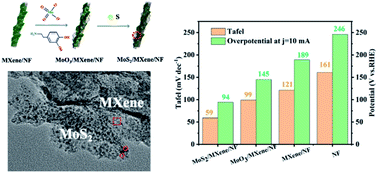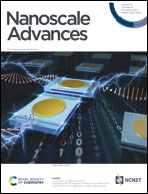Enhanced electrocatalytic hydrogen evolution by molybdenum disulfide nanodots anchored on MXene under alkaline conditions†
Abstract
Efficient hydrogen production through electrocatalysis represents a promising path for the future clean energy. Molybdenum disulfide (MoS2) is a good substitute for platinum-based catalysts, due to its low cost and high activity. However, the limited active sites and low electrical conductivity of MoS2 hinder its large-scale industrial application under alkaline conditions. Herein, we constructed MoS2 nanodots anchored on an MXene/nickel foam (MoS2 NDs/MXene/NF) heterostructure by a cascade polymerization synthesis and in situ vulcanization. The prepared heterostructure displays an ultralow overpotential of 94 mV at a current density of 10 mA cm−2 with a Tafel slope of only 59 mV dec−1 in alkaline (1 M KOH) hydrogen evolution reaction (HER), and is better than conventional MoS2 electrocatalysts reported so far. Fine structural analysis indicates that MoS2 NDs are dispersed uniformly on the surface of the heterostructure with consistent orientation, leading to the improvement of MoS2 conductivity with more paths for electron transfer. Moreover, the orientation of the synthesized MoS2 NDs was verified to expose the more (002) crystal plane, which exhibits higher activity than other planes. Our results demonstrate that MoS2 NDs with heterostructure design and preferential growth can serve as high-efficiency noble-metal free electrocatalysts for the HER in alkaline solution.

- This article is part of the themed collection: Celebrating Nanoscience in China


 Please wait while we load your content...
Please wait while we load your content...